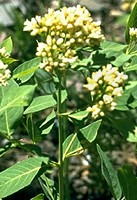| DESCRIPTION: It is a herbaceous plant with stems ascending to erect reaching 30-120 cm in height. Leaves opposite with 5-15 cm long blades. Flower fragrant, small, corolla cylindric to urn-shaped, 5-lobed. The seed pod (follicle) slender, cylindric, pointed, shaped like a smooth, curved green bean, generally longer than 12 cm. A thick milky, poisonous juice exudes from any broken portion of the plant. USE: The flowers are a source of honey. Fibres are extracted from the inner layer of the bark. The fibre is excellent for making fishing lines and nets because it keeps its strength under water and does not shrink. It can also be used in the manufacture of deer nets, slings for hunting small game, nooses for snaring grouse and other game birds, hide stretchers, moccasins, clothing, woven bedding for baby cradles, wheels used in a type of dart game, tump lines and cat-tail mats. For making garments, the fibre was sometimes mixed with deer hair before spinning, Although this plant is considered toxic to humans (and the bane of dogs), the roots were commonly harvested in the 19th and early 20th centuries for a variety of folk medicine and medical purposes. GROWING PERIOD: Perennial. COMMON NAMES: Indian hemp. FURTHER INF: In parts of the United States it is listed as a noxious weed. Found in cultivated fields, pastures, rangeland, open woods, fencerows, roadsides, dry rocky or open woods, glades and prairies. It can be found growing in moist or shady places and is easily cultivated in average, dry to medium wet, well-drained soil. It prefers sandy soil but will grow in most soils in sun or light shade. |
